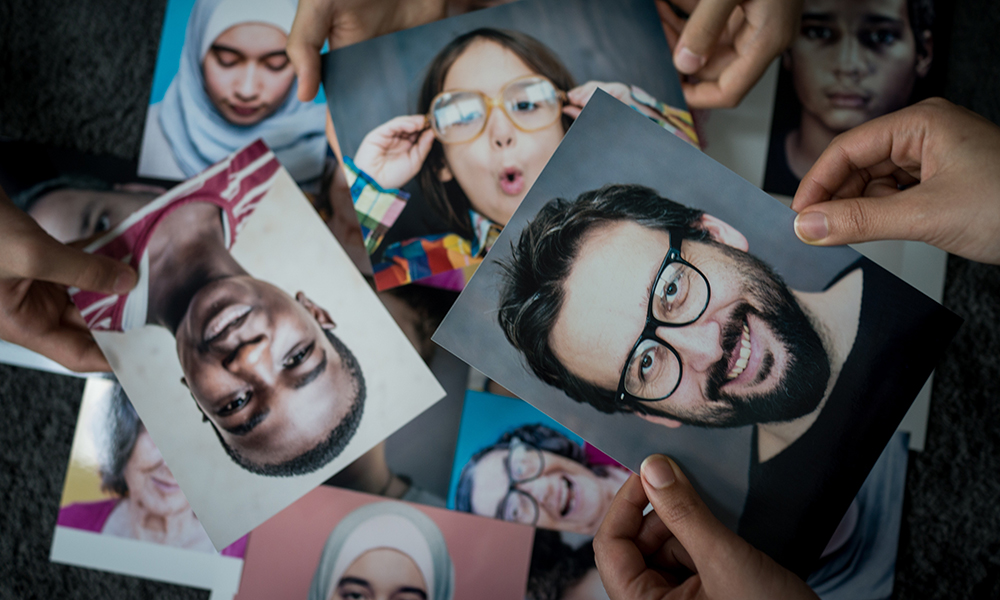
众所周知,在感染新冠病毒的初期,会导致丧失味觉和嗅觉。但现在人们发现了一种新的神经症状:丧失脸部识别能力。
《Cortex》期刊在今年3月发表的一篇报告中介绍了28岁女性安妮的病例。她于2020年3月感染新冠病毒,在此之前并不存在面部识别问题。两个月后,新冠症状复发,她开始出现面部识别困难。
报告作者称,这是第一例有记录的感染新冠病毒后出现面孔失认症的病例。面孔失认症会导致患者无法识别面部。
作者写道:“之前对新冠病毒长期影响的研究报告了记忆力和专注力衰退等症状,这些症状严重影响了患者的日常活动。”
但“新冠病毒除了会造成已知的广泛的人体功能损坏外,有时候还会引发严重的选择性障碍,例如面孔失认症。”
此外,研究人员在其调查的其他大多数长期新冠患者中发现了类似症状,表现形式为视觉/感觉和认知障碍。
作者写道,安妮在2020年春季首次感染急性新冠后康复。但几周后,她开始感到迷惑,“在面部识别方面出现了问题。”在2020年6月的一次家庭聚会中,她发现自己认不出父亲,分不清父亲和叔叔。
她告诉研究人员:“从一个陌生人的脸上传来我父亲的声音。”她表示,现在她严重依赖对于陌生人声音的记忆。
当研究人员要求她识别名人的面容时,她也无法进行测试。
这种新出现的异常症状显然与长期新冠有关。对安妮而言,这种症状尤其具有破坏性影响,因为她是一名客户服务代表,兼职从事肖像画家。她发现在画画的时候,只能完全依赖观察绘画对象的照片。在新冠疫情之前,她在绘画的时候,只需要每隔15分钟或30分钟看一次照片。
她对研究人员表示:“现在,人们的面容在我脑海中一片混沌。”
报告的作者称,安妮现在“观看和记忆他人的面容,就像是不懂中文的情况下看一个汉字,并要求她凭借记忆默写出来一样。”
但这种新发现的视觉障碍,并不限于面部。报告的作者表示,安妮发现自己在食品杂货店里会迷路,会忘掉停车地点,会开车朝着相反的方向驾驶。
作者称,安妮还有其他长期新冠症状,包括复发的新冠症状、疲劳、无法集中注意力和脑雾等。2020年11月,距离最初感染新冠病毒九个月后,她开始出现平衡问题以及经常性偏头痛。
为了了解其他长期新冠患者是否存在类似的问题,研究人员又调查了54名病毒后疾病患者。尽管他们并未找到与安妮的症状完全相同的患者,但他们发现,大多数患者表示,他们识别人和物体、识别声音和电话号码以及理解阅读内容的能力均出现下降。
专家表示,目前已经识别的长期新冠症状超过200种,比如长期咳嗽和疲劳、耳朵麻木和“大脑着火”的感觉等,因此长期新冠毫无疑问并不是一种而是多种疾病。
有人认为,对于真正的长期新冠,最合理的定义是在感染新冠病毒之后出现的慢性类疲劳综合征症状,类似于感染疱疹、莱姆病(Lyme disease)和埃博拉(Ebola)等之后出现的其他病毒后综合征。
有专家表示,其他新冠后综合征,例如器官损伤等,不应该定义为长期新冠,而是应该将其划分为范围更广的新冠感染急性后遗症(PASC)。新冠感染急性后遗症包含了各种新冠病毒导致的后果,比如慢性类疲劳综合征、后续心脏病、持续肺损伤以及尿失禁、瘙痒和皮肤损害等奇怪的新症状等。
1月26日,凯撒家庭基金会(Kaiser Family Foundation)的报告引用美国疾病控制与预防中心(U.S. Centers for Disease Control and Prevention)的数据称,截至1月16日,15%的美国成年人表示在新冠疫情期间经历过长期新冠症状,6%的成年人表示存在挥之不去的长期症状。
报告称,美国的新冠患者表示依旧存在长期新冠症状的比例从去年6月的19%下降到今年1月的11%。(财富中文网)
翻译:刘进龙
审校:汪皓
众所周知,在感染新冠病毒的初期,会导致丧失味觉和嗅觉。但现在人们发现了一种新的神经症状:丧失脸部识别能力。
《Cortex》期刊在今年3月发表的一篇报告中介绍了28岁女性安妮的病例。她于2020年3月感染新冠病毒,在此之前并不存在面部识别问题。两个月后,新冠症状复发,她开始出现面部识别困难。
报告作者称,这是第一例有记录的感染新冠病毒后出现面孔失认症的病例。面孔失认症会导致患者无法识别面部。
作者写道:“之前对新冠病毒长期影响的研究报告了记忆力和专注力衰退等症状,这些症状严重影响了患者的日常活动。”
但“新冠病毒除了会造成已知的广泛的人体功能损坏外,有时候还会引发严重的选择性障碍,例如面孔失认症。”
此外,研究人员在其调查的其他大多数长期新冠患者中发现了类似症状,表现形式为视觉/感觉和认知障碍。
作者写道,安妮在2020年春季首次感染急性新冠后康复。但几周后,她开始感到迷惑,“在面部识别方面出现了问题。”在2020年6月的一次家庭聚会中,她发现自己认不出父亲,分不清父亲和叔叔。
她告诉研究人员:“从一个陌生人的脸上传来我父亲的声音。”她表示,现在她严重依赖对于陌生人声音的记忆。
当研究人员要求她识别名人的面容时,她也无法进行测试。
这种新出现的异常症状显然与长期新冠有关。对安妮而言,这种症状尤其具有破坏性影响,因为她是一名客户服务代表,兼职从事肖像画家。她发现在画画的时候,只能完全依赖观察绘画对象的照片。在新冠疫情之前,她在绘画的时候,只需要每隔15分钟或30分钟看一次照片。
她对研究人员表示:“现在,人们的面容在我脑海中一片混沌。”
报告的作者称,安妮现在“观看和记忆他人的面容,就像是不懂中文的情况下看一个汉字,并要求她凭借记忆默写出来一样。”
但这种新发现的视觉障碍,并不限于面部。报告的作者表示,安妮发现自己在食品杂货店里会迷路,会忘掉停车地点,会开车朝着相反的方向驾驶。
作者称,安妮还有其他长期新冠症状,包括复发的新冠症状、疲劳、无法集中注意力和脑雾等。2020年11月,距离最初感染新冠病毒九个月后,她开始出现平衡问题以及经常性偏头痛。
为了了解其他长期新冠患者是否存在类似的问题,研究人员又调查了54名病毒后疾病患者。尽管他们并未找到与安妮的症状完全相同的患者,但他们发现,大多数患者表示,他们识别人和物体、识别声音和电话号码以及理解阅读内容的能力均出现下降。
专家表示,目前已经识别的长期新冠症状超过200种,比如长期咳嗽和疲劳、耳朵麻木和“大脑着火”的感觉等,因此长期新冠毫无疑问并不是一种而是多种疾病。
有人认为,对于真正的长期新冠,最合理的定义是在感染新冠病毒之后出现的慢性类疲劳综合征症状,类似于感染疱疹、莱姆病(Lyme disease)和埃博拉(Ebola)等之后出现的其他病毒后综合征。
有专家表示,其他新冠后综合征,例如器官损伤等,不应该定义为长期新冠,而是应该将其划分为范围更广的新冠感染急性后遗症(PASC)。新冠感染急性后遗症包含了各种新冠病毒导致的后果,比如慢性类疲劳综合征、后续心脏病、持续肺损伤以及尿失禁、瘙痒和皮肤损害等奇怪的新症状等。
1月26日,凯撒家庭基金会(Kaiser Family Foundation)的报告引用美国疾病控制与预防中心(U.S. Centers for Disease Control and Prevention)的数据称,截至1月16日,15%的美国成年人表示在新冠疫情期间经历过长期新冠症状,6%的成年人表示存在挥之不去的长期症状。
报告称,美国的新冠患者表示依旧存在长期新冠症状的比例从去年6月的19%下降到今年1月的11%。(财富中文网)
翻译:刘进龙
审校:汪皓
COVID was infamous in its early days for causing loss of taste and smell. Now, another odd neurological symptom has been documented: loss of the ability to recognize faces.
A report published this month in the journal Cortex describes the case of Annie, a 28-year-old woman who had no trouble recognizing faces prior to coming down with COVID in March 2020. Two months later, when her COVID symptoms returned, she began experiencing difficulty recognizing faces.
It’s the first documented report of prosopagnosia—a neurological disorder that makes distinguishing faces impossible—after COVID-19, according to the study’s authors.
“Previous studies of the long-term effects of COVID-19 have reported deficits in memory, attention, and concentration that substantially impair everyday functioning,” the authors write.
But “in addition to the well-known broad impairments, COVID-19 sometimes causes severe selective impairments like prosopagnosia.”
What’s more, researchers found similar symptoms—in the form of visual/perceptual and cognitive difficulties—in most other long COVID patients surveyed.
Annie recovered after an initial acute COVID illness in the spring of 2020, the authors write. But several weeks later, she began to feel disoriented, and that “something was off with faces.” At a family get-together in June of that year, she noted that she didn’t recognize her father, and that she couldn’t tell him apart from her uncle.
“My dad’s voice came out of a stranger’s face,” she told researchers, adding that she now relies heavily on her memory of strangers’ voices.
She also struggled on a test in which researchers asked to recognize faces of celebrities.
For Annie, the new and unusual symptom—apparently tied to long COVID—was especially disruptive: She works as a customer service representative and part time portrait artist. She now finds herself fully dependent on looking at photos of her subjects while drawing. Prior to COVID, she only had to reference a picture once every 15 or 30 minutes while working.
Now, “Faces are like water in my head,” she told researchers.
Annie now “equates looking at and then trying to remember faces to viewing a Chinese character without any knowledge of the language, and then being asked to reproduce it from memory,” the authors write.
But her newfound visual difficulties aren’t limited to faces. She also finds herself getting lost in the grocery store, forgetting where she parked, and driving in the direction opposite of where she intended to go, the authors add.
Annie has other symptoms of long COVID, the authors note, including relapses of COVID symptoms, fatigue, trouble concentrating, and brain fog. In November 2020, nine months after her first COVID infection, she began experiencing balance issues and frequent migraines, too.
To see if other long COVID sufferers were struggling with the same or similar issues, researchers surveyed a group of 54 others with the post-viral illness. They found that most reported major drops in their ability to identify people and objects, recognize voices, remember phone numbers, and understand what they read—though they didn’t find additional patients with the exact same condition.
With more than 200 symptoms identified—from lingering cough and fatigue to ear numbness and a sensation of “brain on fire”—long COVID is undoubtedly not one but multiple conditions, experts say.
True long COVID, some contend, is best defined as a chronic-fatigue-syndrome-like condition that develops after a COVID infection, similar to other post-viral syndromes that can occur after an infection with herpes, Lyme disease, and Ebola, among others.
Other post-COVID complications like organ damage should not be defined as long COVID and better fit into the larger umbrella category of PASC, some experts say. Also known as post-acute sequelae of COVID-19, the term is used to encompass a wide variety of COVID consequences, from chronic-fatigue-like symptoms and subsequent heart disease to lasting lung damage and odd new symptoms like urinary incontinence, itching, and skin lesions.
As of Jan. 16, 15% of U.S. adults reported having long COVID symptoms at some point in the pandemic, and 6% reported lingering symptoms, according to a Jan. 26 report by the Kaiser Family Foundation, citing data from the U.S. Centers for Disease Control and Prevention.
The percent of Americans who’ve experienced COVID and still report long COVID symptoms dropped from 19% in June to 11% in January, according to the report.






